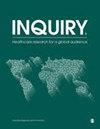基础代谢率与膳食维生素 D 和钙摄入量以及与慢性脊髓损伤后身体成分和骨骼健康的关系
IF 1.7
4区 医学
Q3 HEALTH CARE SCIENCES & SERVICES
Inquiry-The Journal of Health Care Organization Provision and Financing
Pub Date : 2024-09-14
DOI:10.1177/00469580241278018
引用次数: 0
摘要
我们研究了脊髓损伤(SCI)后基础代谢率(BMR)以及膳食中维生素 D(Vit D)和钙摄入量与身体组成和骨矿物质密度(BMD)之间的关系。横断面设计。弗吉尼亚州里士满退伍军人事务医疗中心。约 33 名慢性脊髓损伤患者在两周内每周记录 3 天的食物摄入量。隔夜禁食 10 到 12 小时后测量 BMR。使用研究营养数据系统(NDSR)软件记录和分析每日维生素 D 和钙的平均摄入量以及总热量摄入量。对空腹血液中 25- 羟基维生素 D(25[OH]D)和三碘甲状腺原氨酸(T3)的状况进行了分析(n = 10)。通过双 X 射线吸收扫描测量了总 BMD 和区域 BMD、脂肪量百分比 (FM) 和瘦肉量百分比 (LM)。参与者的维生素D摄入量(600-800 IU)和钙摄入量(1000-1200 mg)均低于美国医学研究所(IOM)推荐的成人每日允许摄入量(RDA)。基础代谢率与总瘦体重(r = .62,P = .0001;n = 32)和腿瘦体重(r = .51,P = .003;n = 32)呈正相关。调整后的基础代谢率与左侧(r = -.38,P = .047;n = 28)和右侧(r = -.41,P = .032;n = 28)胫骨近端的 BMD 呈负相关。维生素 D 摄入量与总 FM 百分比(r = -.33, P = .07; n = 29)和腿部 FM 百分比(r = -.37, P = .047; n = 29)呈负相关。多变量回归模型表明,调整后的血液容积可以解释腿部脂肪量(34%;P = .002)和脂肪量百分比(44%;P < .0001)的差异。SCI 患者的维生素 D 和钙摄入量很可能低于 RDA 标准。基础代谢率可以解释身体成分和骨代谢的变化。膳食中的维生素 D 应被视为维持 SCI 后骨骼健康的预防性干预措施。本文章由计算机程序翻译,如有差异,请以英文原文为准。
Basal Metabolic Rate Versus Dietary Vitamin D and Calcium Intakes and the Association With Body Composition and Bone Health After Chronic Spinal Cord Injury
We examined the association among basal metabolic rate (BMR) as well as dietary intakes of vitamin D (Vit D) and calcium on body composition and bone mineral density (BMD) after spinal cord injury (SCI). Cross-sectional design. Veterans Affairs Medical Center, Richmond, VA. About 33 individuals with chronic SCI who recorded their food consumption 3 days per week for 2 weeks. BMR was measured after 10 to 12 h of overnight fast. Average daily vit D and calcium intakes, and total caloric intake were recorded and analyzed using the Nutrition Data System for Research (NDSR) software. Fasting blood analysis for 25-hydroxyvitamin D (25[OH]D) status and Triiodothyronine (T3) status was performed (n = 10). Total and regional BMD, % fat mass (FM), and % lean mass (LM) were measured by dual X-ray absorptiometry scans. Participants consumed less than the Institute of Medicine (IOM) recommended daily allowances (RDA) for vit D (600-800 IU) and calcium (1000-1200 mg) for adults. BMR was positively related to total-lean mass ( r = .62, P = .0001; n = 32) and leg-lean mass ( r = .51, P = .003; n = 32). Adjusted BMR was negatively related to BMD of the left (r = −.38, P = .047; n = 28) and the right (r = −.41, P = .032; n = 28) proximal tibia. Vit D intake was negatively related to percentage total-FM ( r = −.33, P = .07; n = 29) and legs-%FM ( r = −.37, P = .047; n = 29). Multivariate regression models indicated that adjusted BMR explained the variance in leg fat mass (34%; P = .002) and percentage fat mass (44%; P < .0001). Persons with SCI are likely to consume less than the RDAs for vit D and calcium. BMR may explain the changes in body composition and bone metabolism. Dietary vit D should be considered as a prophylactic intervention in maintenance of bone health after SCI.
求助全文
通过发布文献求助,成功后即可免费获取论文全文。
去求助
来源期刊
CiteScore
2.50
自引率
0.00%
发文量
192
审稿时长
>12 weeks
期刊介绍:
INQUIRY is a peer-reviewed open access journal whose msision is to to improve health by sharing research spanning health care, including public health, health services, and health policy.

 求助内容:
求助内容: 应助结果提醒方式:
应助结果提醒方式:


